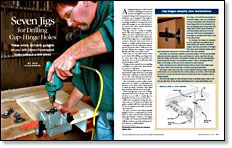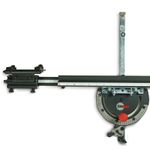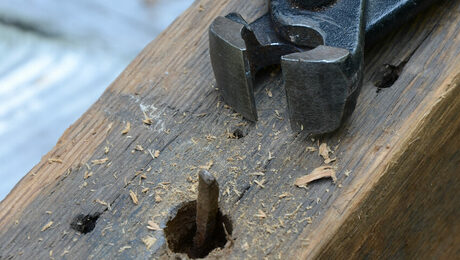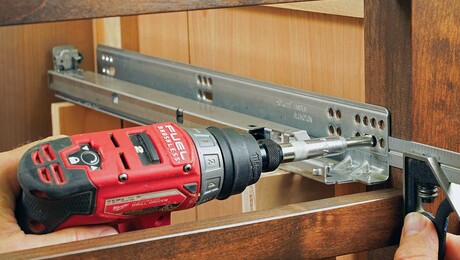Seven Jigs for Drilling Cup-Hinge Holes
These small, portable gadgets let you drill 35mm Forstner-bit holes without a drill press
Synopsis: A cup hinge installed in a sloppy hole won’t enjoy full strength, and these jigs help you bore holes more accurately. The author takes a look at seven commercial jigs from various manufactures and evaluates the pros and cons of each. You’ll also find sources for each product. Seven models are compared: Euro Easy Drill, Euro-Eze II, Concealed Hinge Jig-It, Veritas Hinge-Boring Jig, Euro Drill, Blum Ecodrill and Fisch Multi-Pattern Euro Jig.
A designated jig just to drill a hole? If you have cup hinges to mount, the answer just might be yes, because to make the hinge both strong and easy to install, the cup is designed to fit snugly into a 35mm hole bored in a cabinet door. A cup hinge installed in a sloppy hole won’t enjoy full strength. So you want the hole to be a good one. That’s exactly what these jigs promise to help you do.
The jigs come in a variety of designs. Some offer stark simplicity at a low cost. Others are more sophisticated and come with a price that reflects that refinement. But all of these jigs have a couple things in common. They get their power from an electric or cordless drill. And they serve as a surrogate tool for the drill press, supporting the 35mm bit when a drill press can’t be used. Without that support, a large bit like this will skitter around the wood.
These jigs are especially handy when you’re faced with drilling cup-hinge holes in a door that’s large and unwieldy. Just clamp the door to your workbench, then mount the jig and drill.
The jigs are also handy if you’re installing cup hinges at a remote site, where there’s no access to a drill press.
All of the jigs allow you to adjust the distance from the edge of the door to the edge of the hole—a dimension called the “backset” or “tab.” This dimension provides the necessary clearance for the door to open.
Also, each jig has a mark, usually a notch, that serves as a guide to positioning it on the door. Use a square and a sharp pencil to mark the hinge centerline. Then align the pencil line with the notch on the jig.
Most of the jigs have some sort of clamping system that anchors the jig to the cabinet door as you drill. A couple jigs are handheld. One has to be screwed down.
With a few exceptions, the jigs also provide some sort of means to position and guide a smaller drill bit to bore pilot holes for two mounting screws that secure the cup to the door.
It’s easy to see how one of these portable gadgets can have a useful place in a workshop. So when asked by Fine Woodworking to give the jigs a workout, I was happy to comply.
From Fine Woodworking #148
For the full article, download the PDF below:
Fine Woodworking Recommended Products

Jorgensen 6 inch Bar Clamp Set, 4 Pack

Sawstop Miter Gauge

Estwing Dead-Blow Mallet























Log in or create an account to post a comment.
Sign up Log in